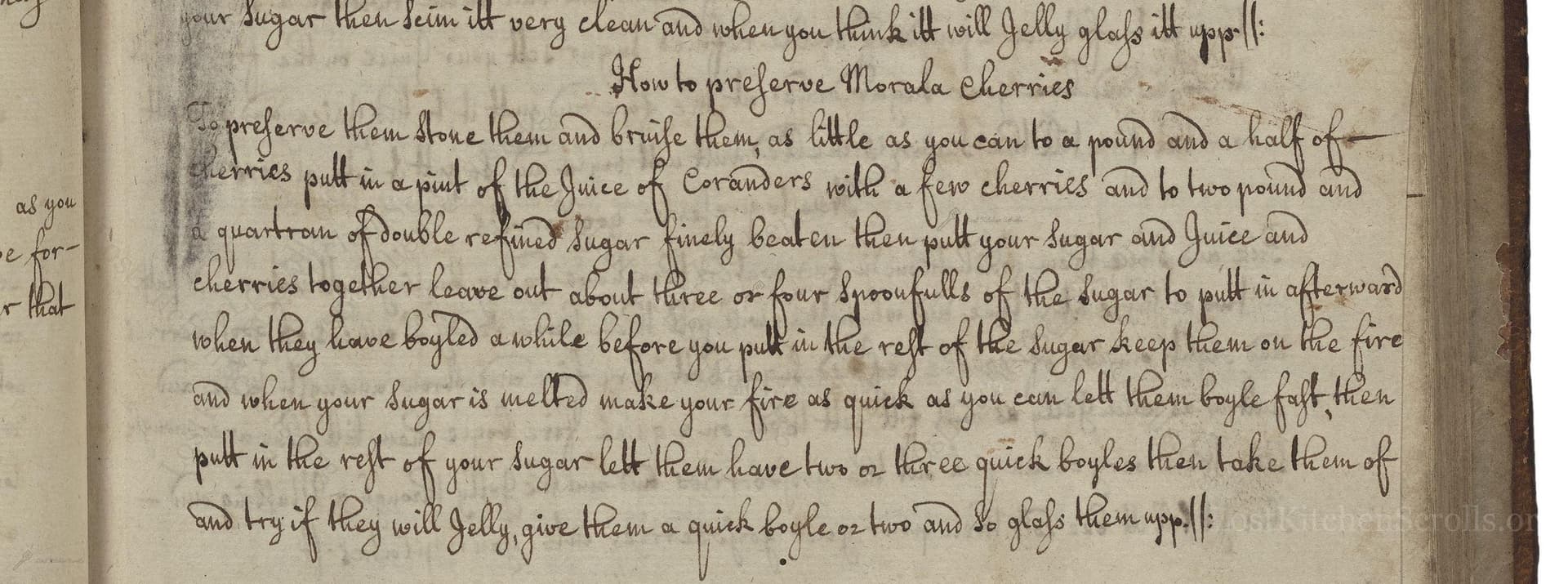How To Preserve Morrela Cherries
From the treasured pages of Mrs. Rachel Kirk Book 1707
Written by Rachel Kirk

How To Preserve Morrela Cherries
"To preserve them Stone them and bruise them, as little as you can to a pound and a half of cherries putt in a pint of the juice of Corranders with a few cherries and to two pound and a quartron of double refined sugar finely beaten then putt your sugar and Juice and cherries together leave out about three or four spoonfulls of the Sugar to putt in afterward when they have boyled a while before you putt in the rest of the Sugar keep them on the fire and when your Sugar is melted make your fire as quick as you can lett them boyle fast then putt in the rest of your sugar lett them have two or three quick boyles then take them of and try if they will jelly, give them a quick boyle or two and so glass them uppll:"
Note on the Original Text
The recipe is written in continuous prose with little punctuation, typical for early 18th-century manuscript instructions aimed at women already familiar with basic kitchen processes. Ingredients and method are mingled, with approximate or non-standard measures ('a pound and a half', 'a quartron', 'spoonfulls'). Spelling is phonetic—‘Corranders’ for currants, ‘pint’ as standard, and ‘quartron’ for a quarter of a pound. The instruction to check if the preserve 'will jelly' refers to the classic wrinkle test for setting point, understood by contemporary cooks. The phrase 'glass them uppll' means to decant into glass jars for display and storage.

Title
Mrs. Rachel Kirk Book 1707 (1707)
You can also click the book image above to peruse the original tome
Writer
Rachel Kirk
Era
1707
Publisher
Unknown
Background
A remarkable collection of early 18th-century recipes, Rachel Kirk's work invites readers into the kitchens of the past where classic culinary traditions and timeless flavors come alive. Expect a charming medley of savory feasts and sweet treats reflective of the era's sophisticated palate.
Kindly made available by
Folger Shakespeare Library
This recipe originates from Rachel Kirk’s manuscript of 1707, a time when preserving fruit was both a necessity and a delicacy. At the start of the 18th century in England, sugar was a prized ingredient, and glass jars ('to glass them uppll') signaled a status of affluence and advanced domestic practice. The use of ‘currander’ juice, clarified in context as currant juice, was common for natural pectin to help set preserves before commercial pectin was available. Written shortly after the Restoration and during a blossoming of culinary literacy among gentlewomen, recipes like this were both practical and performative, intended to showcase a household's prosperity and skill.

Originally, the recipe would have been made with a brass or copper preserving pan over a wood or coal fire, using wooden spoons for stirring. Cherries would have been pitted with small knives, and a sieve or muslin cloth may have been used for extracting currant juice. For storage, the finished preserve would be potted in glass jars or ceramic vessels, sealed with parchment and wax.
Prep Time
20 mins
Cook Time
20 mins
Servings
20
We've done our best to adapt this historical recipe for modern kitchens, but some details may still need refinement. We warmly welcome feedback from fellow cooks and culinary historians — your insights support the entire community!
Ingredients
- 1.5 lbs fresh Morello cherries (ideally; sour cherries, or substitute with best available sour cherry variety)
- 1 pint (16 fl oz) fresh red currant juice (substitute: unsweetened bottled red currant juice if fresh unavailable)
- 2 lbs 7 oz double refined white sugar (modern: caster sugar, very finely ground)
- optional: Additional 3-4 tablespoons (about 1.5-2 oz) of sugar, reserved to add at end
Instructions
- To make preserved Morello cherries as described in 1707, begin by stoning and lightly bruising the cherries, keeping them as whole as possible.
- For every 1.5 lbs of cherries, add about 1 pint (16 fl oz) of red currant juice (as 'Corranders' refers to currants, commonly red or black, though red is typical for jelly-making).
- Mix in 2 lbs 7 oz of finely ground caster sugar, saving about 3-4 tablespoons to add later in the process.
- Combine the cherries, currant juice, and most of the sugar in a heavy-based pot.
- Gently heat until the sugar dissolves, then increase to a rapid boil.
- After a few minutes, add the remaining sugar and boil rapidly for another 2-3 minutes.
- Check if the mixture reaches a soft set or jelly-like consistency.
- When done, remove from heat and pour into sterilized glass jars.
Estimated Calories
120 per serving
Cooking Estimates
It takes about 20 minutes to prepare the cherries, juice, and sugar, and 20 minutes to cook. Each serving is about 60g (around 2 heaped tablespoons), and the recipe makes about 20 servings. Each serving has around 120 calories.
As noted above, we have made our best effort to translate and adapt this historical recipe for modern kitchens, taking into account ingredients nowadays, cooking techniques, measurements, and so on. However, historical recipes often contain assumptions that require interpretation.
We'd love for anyone to help improve these adaptations. Community contributions are highly welcome. If you have suggestions, corrections, or cooking tips based on your experience with this recipe, please share them below.
Join the Discussion
Rate This Recipe
Dietary Preference
Main Ingredients
Culinary Technique

Den Bockfisch In Einer Fleisch Suppen Zu Kochen
This recipe hails from a German manuscript cookbook compiled in 1696, a time whe...

Die Grieß Nudlen Zumachen
This recipe comes from a rather mysterious manuscript cookbook, penned anonymous...

Ein Boudain
This recipe comes from an anonymous German-language manuscript cookbook from 169...

Ein Gesaltzen Citroni
This recipe, dating from 1696, comes from an extensive anonymous German cookbook...
Browse our complete collection of time-honored recipes



